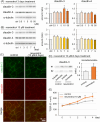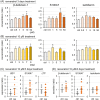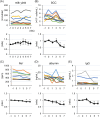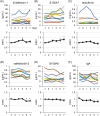Effects of topical application of resveratrol on tight junction barrier and antimicrobial compound production in lactating goat mammary glands
- PMID: 38365712
- PMCID: PMC10870570
- DOI: 10.1186/s13567-024-01276-z
Effects of topical application of resveratrol on tight junction barrier and antimicrobial compound production in lactating goat mammary glands
Abstract
In mammary glands, the formation of less-permeable tight junctions (TJs) and the production of antimicrobial compounds like lactoferrin and defensins are important for preventing mastitis. Resveratrol, a polyphenol contained in red grapes, is known to protect mammary epithelial cells (MECs) from oxidative stress; however, oral administration of resveratrol causes a decrease in certain biological processes through conjugation and metabolic conversion. In this study, we determined the beneficial effects of resveratrol on TJs and antimicrobial compounds in cultured goat MECs by adding it to the medium, and in lactating goat mammary glands by topical application for percutaneous absorption. TJ barrier function was evaluated by transepithelial resistance and expression or localization pattern of claudins for culture model in vitro and by somatic cell count, Na+, albumin, and IgG in milk for topical application in vivo. Concentrations of antimicrobial compounds and cytokines were measured using ELISA. Activation of STAT3 was evaluated by Western blotting. Resveratrol strengthened TJ barrier function by upregulating claudin-3 in cultured MECs and topical application to udders reduced somatic cell count, Na+, albumin, and IgG in milk. Resveratrol increased β-defensin and S100A7 levels in cultured MECs and milk. In addition, resveratrol down-regulated cytokine production and STAT3 pathway. These findings suggest that the topical application of resveratrol to udders may be effective in preventing mastitis.
Keywords: Antimicrobial compound; mammary gland; resveratrol; tight junction.
© 2024. The Author(s).
Conflict of interest statement
The authors declare that they have no competing interests.
Figures






Similar articles
-
Valine Treatment Enhances Antimicrobial Component Production in Mammary Epithelial Cells and the Milk of Lactating Goats Without Influencing the Tight Junction Barrier.J Mammary Gland Biol Neoplasia. 2023 Feb 18;28(1):3. doi: 10.1007/s10911-023-09529-x. J Mammary Gland Biol Neoplasia. 2023. PMID: 36801983 Free PMC article.
-
Potential effects of gingerol topical application on components of the innate immunity in lactating goat mammary glands.Innate Immun. 2023 Oct;29(7):135-149. doi: 10.1177/17534259231191252. Epub 2023 Aug 22. Innate Immun. 2023. PMID: 37605866 Free PMC article.
-
Suppressive effects of curcumin on milk production without inflammatory responses in lactating mammary epithelial cells.Phytomedicine. 2021 Jan;80:153360. doi: 10.1016/j.phymed.2020.153360. Epub 2020 Oct 1. Phytomedicine. 2021. PMID: 33038867
-
Culture Models to Investigate Mechanisms of Milk Production and Blood-Milk Barrier in Mammary Epithelial Cells: a Review and a Protocol.J Mammary Gland Biol Neoplasia. 2023 May 1;28(1):8. doi: 10.1007/s10911-023-09536-y. J Mammary Gland Biol Neoplasia. 2023. PMID: 37126158 Free PMC article. Review.
-
The role of tight junctions in mammary gland function.J Mammary Gland Biol Neoplasia. 2014 Mar;19(1):131-8. doi: 10.1007/s10911-013-9309-1. Epub 2013 Nov 19. J Mammary Gland Biol Neoplasia. 2014. PMID: 24249583 Review.
Cited by
-
Deciphering the colostral-immunity transfer: from mammary gland to neonates small intestine.Vet Res Commun. 2025 Jan 11;49(2):72. doi: 10.1007/s11259-025-10646-7. Vet Res Commun. 2025. PMID: 39798032 Review.
-
Recent advances in the use of resveratrol against Staphylococcus aureus infections (Review).Med Int (Lond). 2024 Aug 30;4(6):67. doi: 10.3892/mi.2024.191. eCollection 2024 Nov-Dec. Med Int (Lond). 2024. PMID: 39268247 Free PMC article. Review.
-
Changes in Antimicrobial Component Concentrations at the Onset of the Dry Period and Peripartum in Dairy Cows.Anim Sci J. 2025 Jan-Dec;96(1):e70085. doi: 10.1111/asj.70085. Anim Sci J. 2025. PMID: 40692397 Free PMC article.
References
-
- Derakhshani H, Fehr KB, Sepehri S, Francoz D, De Buck J, Barkema HW, Plaizier JC, Khafipour E. Invited review: microbiota of the bovine udder: contributing factors and potential implications for udder health and mastitis susceptibility. J Dairy Sci. 2018;101:10605–10625. - PubMed
-
- Roberson JR. Establishing treatment protocols for clinical mastitis. Vet Clin N Am Food Anim Pract. 2003;19:223–234. - PubMed
-
- Murphy JM. The genesis of bovine udder infection and mastitis; the occurrence of streptococcal infection in a cow population during a 7-year period and its relationship to age. Am J Vet Res. 1947;8:29–42. - PubMed
-
- Isobe N. Control mechanisms for producing antimicrobial factors in ruminant mammary gland. Anim Sci J. 2017;88:937–943. - PubMed
MeSH terms
Substances
LinkOut - more resources
Full Text Sources
Medical
Research Materials
Miscellaneous

